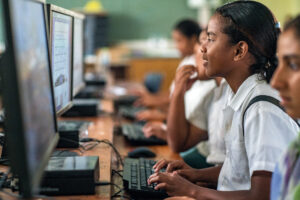Higher education serves as the cornerstone of national development, shaping the destiny of nations through the classrooms that mold the minds of future leaders and innovators. In the case of Pakistan, attaining higher education has been both a pursuit of hunger and an aspiration for change. While the youth believe in the transformative power of education, the glass of higher education in Pakistan remains disconcertingly empty, entangled in a web of challenges that need urgent attention. Let’s unravel the multifaceted issues plaguing higher education in Pakistan and propose innovative solutions to pave the way for a brighter future.
Rising Cost of Education
The commercialization of education has turned learning into a business, with educational institutions frequently escalating tuition fees. This has become a significant obstacle for the economically disadvantaged, pushing them further from accessing higher education. According to the Economic Survey 2022-2023, Pakistan has a significant illiteracy rate of 59.3 percent. This alarming statistic underscores the critical imperative to tackle the accessibility and affordability challenges in education urgently.

Privatization of Public Universities
The growing trend of privatizing public universities exacerbates the hurdles to higher education. Privatization often results in higher costs, rendering it inaccessible for many students. Public universities seeking private funding compromise the essence of accessible education, contributing to the widening gap between the privileged and the underprivileged.
Inadequate Teaching Faculty
The appointment of professors, often influenced by references or external pressure, leads to a shortage of extensively experienced faculty members in public sector universities. The lack of highly qualified instructors and the appointment of lecturers based solely on education credentials contribute to the ineffectiveness of higher education. The deficiency in competent faculty further inhibits the development of skilled and knowledgeable graduates.

Prospects and Recommendations:
- Universities must adopt a practical approach to make education more cost-effective. This involves examining expenditures, exploring alternative funding sources, and ensuring that the burden of high tuition fees is alleviated. The government should play a pivotal role in providing financial assistance to public sector universities, making quality education accessible during economic inflation.
- Shifting from traditional teaching methods to more interactive and innovative approaches is imperative. Adopting methods that actively engage students in case studies, research, and practical applications catalyzes sparking creativity and fostering critical thinking skills.
- Encouraging universities to focus on research and development is crucial for producing competent graduates. Providing incentives for professors to engage in research, fostering collaborations with industries, and establishing research-oriented centers within universities can elevate the standard of higher education in Pakistan.
- Revisiting the grading system to emphasize innovation and creativity over rote learning is essential. A more holistic evaluation approach that recognizes and rewards innovation, critical thinking, and problem-solving skills will empower students to become leaders in their respective fields.
The Way Forward
The challenges confronting higher education in Pakistan are formidable, but the prospects for positive change are within reach. Pakistan can transform its higher education landscape by addressing affordability, curriculum, faculty, and teaching methods. Innovative solutions, coupled with government support and a commitment to fostering creativity and critical thinking, can unlock the true potential of higher education in the country. It is time to envision a future where higher education is not just a privilege for a few but a catalyst for national progress and prosperity.
Disclaimer: Any opinions expressed in this blog do not necessarily reflect the opinions of CREDP. This content is meant for informational purposes only.






